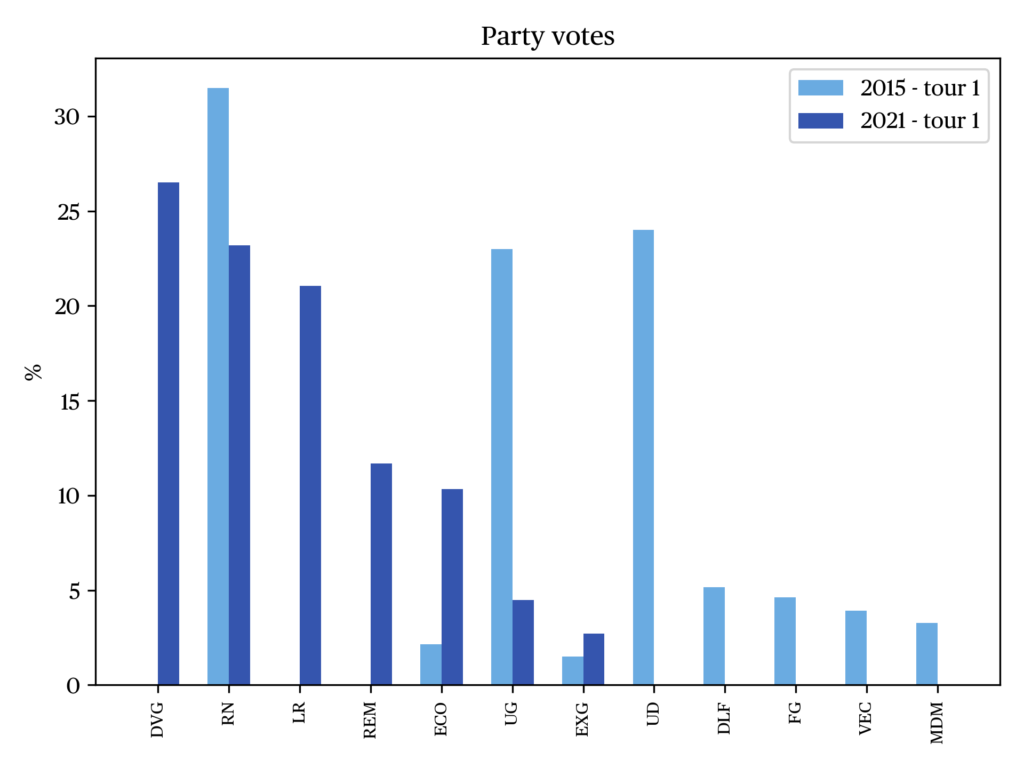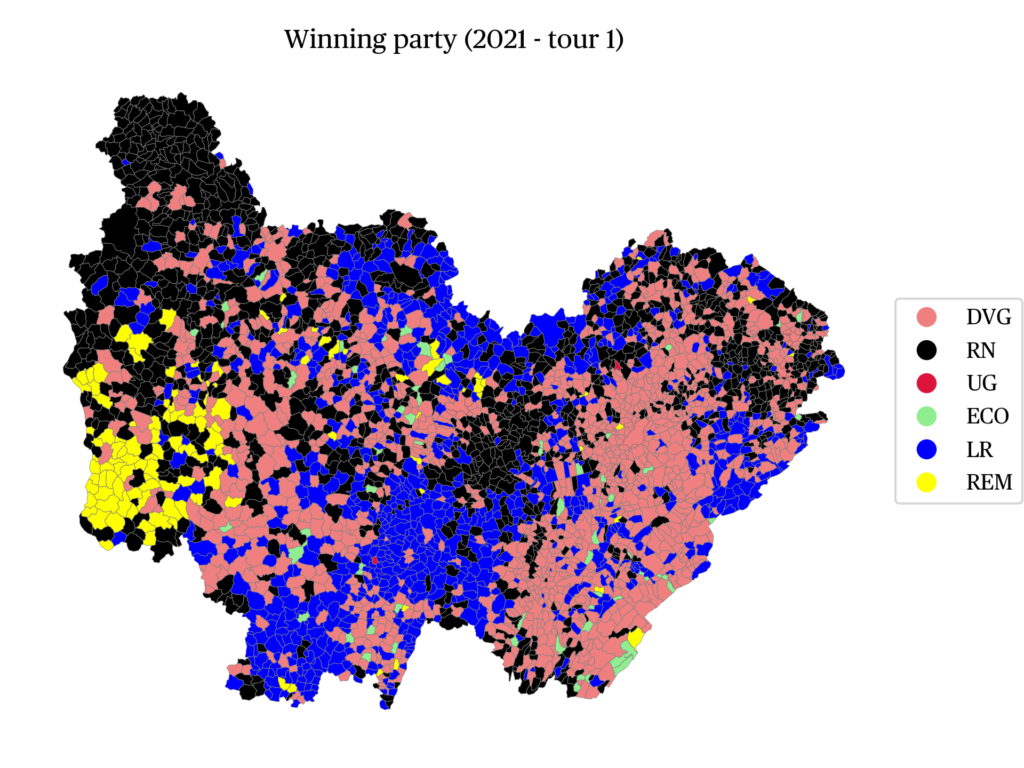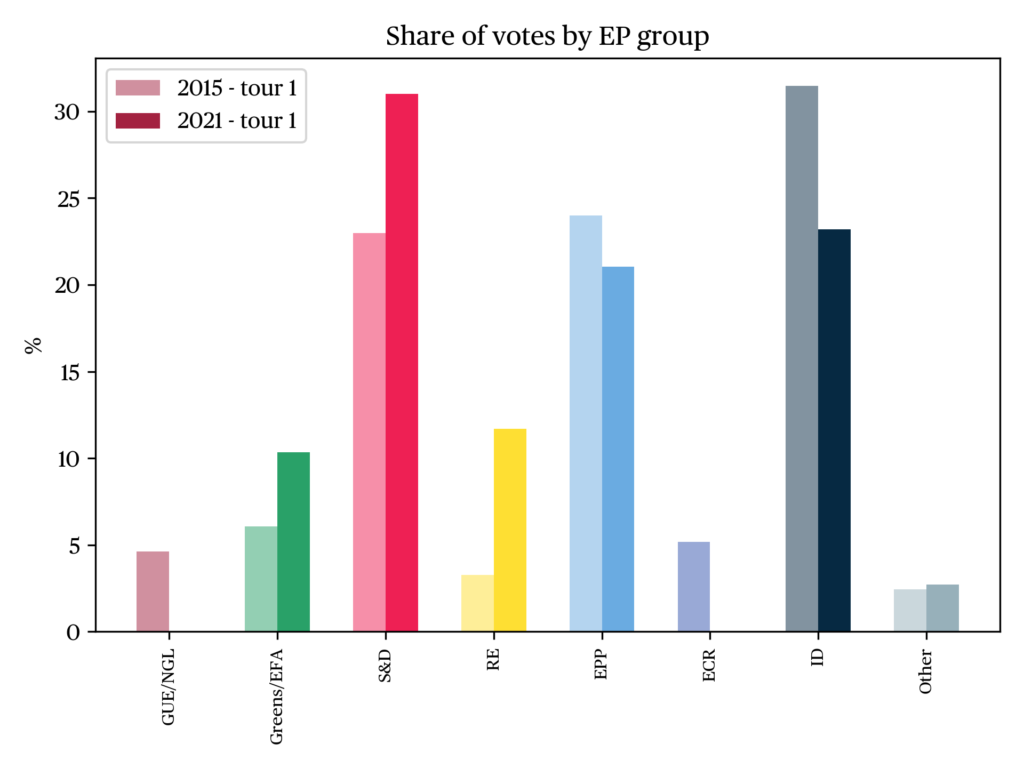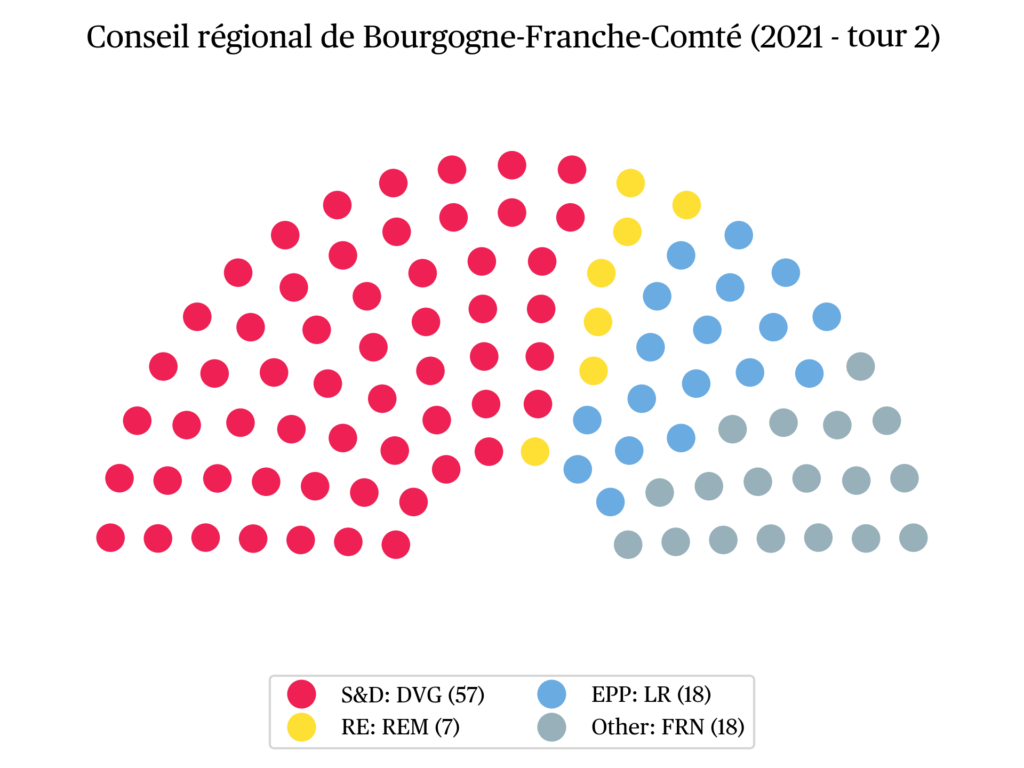Regional election in Bourgogne-Franche-Comté, 20-27 June 2021
Dominique Andolfatto
Professor of political science at the Université de BourgogneIssue
Issue #2Auteurs
Dominique Andolfatto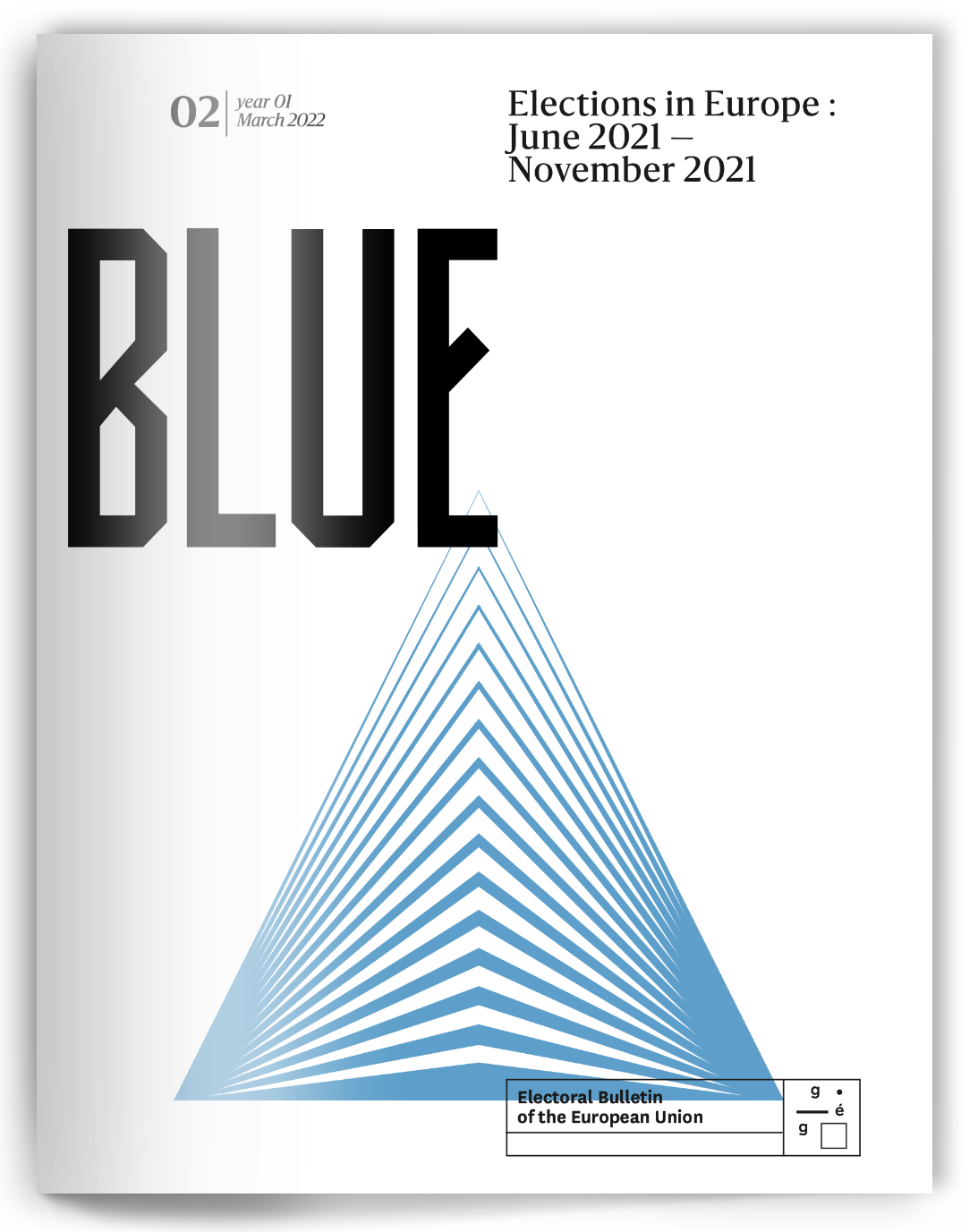
21x29,7cm - 167 pages Issue 2, March 2021 24,00€
Elections in Europe : June 2021 – November 2021
On June 20 and 27, 2021, the seventh regional elections since the decentralization laws of 1982 and 1985 were held in France. These laws made the regions — which result from successive regroupings of the departments over the course of the 20th and 21st centuries — territorial authorities administered by regional councils elected by direct universal suffrage.
1
The most recent law, the “NOTRe” law of 2015 (an acronym standing for “Law on the New Territorial Organization of the Republic”) re-divided continental France into 12 regions, merging the former regions of Burgundy and Franche-Comté.
2
What analysis can be made of these elections in this region of central-eastern France, where they were held for the second time? Three main points — supported by electoral data and maps — are addressed: the electoral offer and campaign; the surge in abstention; electoral audiences and their evolution.
Seven running lists and a bland campaign
Seven party lists were competing for these elections in Bourgogne-Franche-Comté (BFC), compared to ten in 2015. We briefly review these lists, from the left to the right of the political spectrum.
The first two lists came from the far left. The first list represented LO (Working-class Struggle) and was led by Claire Rocher, a nurse at the University Hospital of Dijon and a long-time party activist, who already headed the list of the same party in the 2015 elections. The second list was led by Bastien Faudot, a city councilor of Belfort. It involved various political associations including LFI (Unbowed France) and GRS (Republican and Socialist Left), a micro-party composed of former members of the left wing of the PS (Socialist Party) and the MRC (Citizen and Republican Movement, which for many years was led by its founder Jean-Pierre Chevènement, a former minister and a significant regional figure).
3
Faudot himself was a member of the GRS (Tenoux, 2021). Due to their lack of support in the first round (see Table 1), these two lists were unable to advance to the second round, and were not either allowed to merge with other lists.
4
The third list was led by the outgoing president of the regional council, Marie-Guite Dufay (PS), a retired employment center executive. Dufay became President of the Franche Comté region by succeeding Raymond Forni (PS) in 2008 (at that time, she also served as deputy mayor of Besançon), and became the first President of BFC in 2015. In 2021, she logically headed a traditional “Union of the Left” list, comprising socialists, communists and left-wing radicals. In the second round, this list also included some candidates from EELV (Europe Ecology – The Greens) — the fourth list in the region — which had obtained 10% of the vote in the first round but opted for a tactical merger with the other left-wing list in the second round. This list was led by Stéphanie Modde, a former regional councillor of Burgundy (2004-2015) and municipal councilor of Dijon (2008-2020). The autonomous Green lists that Modde had led in the past — in 2015 (at the regional level) and 2020 (in Dijon) — had not reached 5% of the votes cast, which did not allow them to qualify for the second round. This also explains why the region previously did not have any outgoing Green councilors. In 2021, the hurdles that had led to this double defeat were eventually overcome by the Greens.
The fifth list was that of The Republic in Motion (LREM), the “presidential majority”. It was led by lawyer and former PS member Denis Thuriot, who has served as the mayor of Nevers (33,000 inhabitants) since 2014, when he defeated the socialist incumbent with the support of center-right and center parties. Since 2016, he has got closer to Emmanuel Macron and LREM. Having garnered 11.7% of the votes cast in the first round, his list qualified for the second round.
The sixth list was that of Gilles Platret, the mayor of Chalon-sur-Saône (45,000 inhabitants) since 2014. A former member of the RPR, Platret now ran for the Republicans (LR), whose list he led in 2021 regional election. His list was also supported by the UDI (Union of Democrats and Independents) and DLF (France Arise), a party that presented its own list in 2015.
The seventh and final list was that of the RN (National Rally, formerly the National Front, FN). It was led by Julien Odoul who, after having been a member of the PS, the New Centre and later the UDI, joined the FN in 2015. He was elected regional councillor of Burgundy-Franche-Comté that same year. The regional list of the FN was then led by Sophie Montel who broke with the FN in 2017 to briefly join Florian Philippot’s “Patriots” party. In 2021, Odoul himself took over the leadership of the RN for the regional election. In the days following the election, he was appointed national spokesperson of the RN.

In a context dominated by the COVID-19 epidemic, the campaign for the regional elections, with its specific stakes, hardly aroused voters’ interest: in an Ifop poll conducted in June 2021, only 24% of voters expressed interest for the election (compared to 41% during the 2020 municipal election or 72% during the 2017 presidential election) (Coulange and Manternach, 2021). In the late Spring of 2021, months of health crisis and restrictions on public liberties, which were only partially lifted as of May 2021 (Patriat, 2021), had durably distracted citizens’ attention from regional issues.
In the French context, allowing genuinely regional political dynamics to emerge has always been a challenge… especially since the election is organized at departmental level. Evidence of limited regionalization can be found e.g. in a study of the 2010 regional election in the region of Lorraine, which shows that territorial factors, when they exist, are dominated by the nationalization of electoral behavior (Andolfatto, 2011). As the identities of the region — whose map was redrawn in 2015 — as well as their institutional leverage remain weak, an autonomous regional political scene hardly exists, and elected officials — in this case from Burgundy and Franche-Comté (the absence of a common name is in itself revealing) — have not really tried to create one since 2015. Rather, the creation of “greater regions” has given rise to a surge in parochialism in those regions that disappeared in the merger, feeding sterile competition and undermining the affirmation of the new regions. This situation has had an especially strong impact on the BFC region, due in particular to the competition between the two former regional capitals, Besançon and Dijon. As a result, the new “greater region” has not really found popular legitimacy. More structurally, the place of the regions in the French administrative organization — like their share of public spending — remains limited, even if it tends to increase. In 2020, total regional spending accounted for less than 18 per cent of local government spending (and less than 9 per cent of total state spending).
That said, during the health crisis, the president of the BFC regional council did stand out of the crowd — and, by so doing, also made herself known to the general public, who to a large extent did not know her before — by ordering face masks that were requisitioned upon their arrival at Basel-Mulhouse airport (de Lavergne, 2020; Tenoux and Rof, 2020) by the authorities of the neighboring Grand-Est region. This resulted in tensions with the Grand-Est regional prefect and regional health agency, reflecting the unpreparedness and confusion that prevailed at the beginning of the health crisis. It also reveals the tensions that existed — and even persist — between a state administration marked by Jacobinism, on the one hand, and territorial administrations and local elected officials, on the other.
A few weeks before the regional elections, the president of the regional council of BFC also spoke out in various national media on the issue of euthanasia, following the death (by assisted suicide in Switzerland) of a former political figure from Franche-Comté with whom she was very close, Paulette Guinchard-Kunster. Guinchard-Kunster had served as a member of the National Assembly for the department of Doubs and had been a secretary of state in the Jospin government. Marie-Guite Dufay called for “changing a law [which] is not sufficient to honor the wishes of those who are lucid, suffer and know they cannot be cured” (Dufay, 2021).
In spite of these positions or acts — however important or symbolic they may be — it seems very difficult to speak of the existence of a regional political scene in Burgundy-Franche-Comté. The campaign has been dominated by speculation over the relative strength of the various political forces (and of the RN in particular), as well as over real or alleged negotiations between organizations — would the ecologists join the Dufay list in the second round? would the LREM list advance to the second round? — much more than by regional of public policy issues. This context, both structural and conjunctural, partially explains the record levels of abstention in the 2021 election.

A surge in abstention
The 2021 regional elections saw record levels of abstention, both at the national level (66,7% of registered voters in the first round) and in Burgundy-Franche-Comté specifically (65,1%). Only one in three voters went to the polls. Abstention levels have been rising steadily since regional councils have first been elected by direct universal suffrage (see Figure a), reaching a record high in 2010 before declining slightly in 2015. The 2015 regional elections were — at least partially — perceived as intermediary elections in which voters could express dissatisfaction with the political coalition in power (and, in this case, with François Hollande’s policies). Moreover, in the context of great political confusion that followed the Islamist attacks of 2015, it was feared that the National Front could take over regional governments — especially in BFC, where a FN victory was announced. This had boosted participation, particularly in the second round (61.1% in BFC).
5
Between the 2015 and 2021 elections, abstention thus increased sharply, by 26 percentage points (in BFC), corresponding to a 67% increase vis-à-vis 2015. More fundamental and conjunctural reasons explain this change.
The analysis of the causes of abstention in regional elections proposed by Pierre Bréchon ten years ago could be reconfirmed in full: “On the one hand, most regions lack a strong sense of identity. Regional elected officials still have rather limited competences and, as France is still very Jacobin [centralized], their action is poorly known (…). On the other hand, there has been a trend towards increased abstention in almost all elections since the late 1980s” (Bréchon, 2011, p. 44).
In addition to this lack of institutional recognition and democratic crisis, turnout was also affected by conjunctural effects of the COVID-19 pandemic and its management by public authorities, not to mention the fear it generated — a fear which, to some extent, tended to be fueled by public authorities themselves. The abstention rate was already very high during the 2020 municipal elections. In addition, in BFC, the mortality rate due to the COVID-19 epidemic was higher than the national average (see Figure b). Despite this fact, abstention in the BFC regional election was only slightly lower than average. Levels of abstention, however, varied widely between departments (see Table in the appendix). Haute-Saône and, secondarily, Côte d’Or are the departments with the highest turnout. This can hardly be explained by the tendency of lower levels of urbanization to induce stronger social control over electoral behavior: in fact, this trend can also be observed in other departments, and Haute-Saône and Côte d’Or also include significant urban areas. Conversely, Saône-et-Loire and Territoire-de-Belfort display the highest proportion of non-voters. Again, explaining these differences is difficult: undoubtedly, the feeling of belonging to the greater BFC region is weaker in the latter two departments than in the former (Haute-Saône and Côte d’Or). The Territoire-de-Belfort also appears to be more oriented towards Alsace, while a large part of Saône-et-Loire is (at least economically) connected to the Lyon region.
Figure c presents mortality due to COVID-19 per 10,000 inhabitants in France and in the BFC region. This data does not include COVID-related mortality in institutions other than hospitals and retirement homes, for which no regional data is available. Taking into account out-of-hospital deaths in national aggregates results in an increase in the level of mortality due to COVID-19 by 23% as of November 30, 2021.

Analysis of the results: A tri-polar political system
Figure d presents the results of a principal component analysis (PCA) based, for each list, on the scores obtained in each municipality. The coordinates of the points correspond to the respective average positions of each list on the first two axes of the PCA. This graph accounts for more than two-thirds of the variance of the complete table of all the scores (68%). It therefore summarizes the main contrasts at work during this election.
The first dimension (horizontal axis; 37% of variance) opposes the LR list to all the others, but particularly to the Dufay list. The second dimension (vertical axis; 31% of variance), which is almost as important as the first one, opposes the RN list to all the others, and especially to the Dufay list. In other words, there are three main electorates (far right, liberal right, left), not aligned on the classic right-left scale, but arranged like the three vertices of an equilateral triangle, i.e. equidistant from each other. Curiously, the Ecologists are at the orthocenter of this same triangle, i.e. at almost equal distance from the other three electorates.
6
To understand this singular arrangement, a more in-depth investigation would be necessary, as did A. Siegfried (2010)
7
by analyzing the sociological characteristics and political traditions of each of the spaces dominated by these four electorates. It is also important to measure the respective dynamics of these electorates.

Decline in voter support
Due to the sharp increase in abstention, support for all party lists but the Ecologists’ declined — or even collapsed — in absolute terms (in 2015, Ecologists ran on two different lists). Note that that these changes are measured in relation to registered voters, which reflects the actual share of the various parties in the electorate. The choice of this measure of audiences in relation to registered voters is all the more important given that abstention was very high in both rounds of voting.
8
Ignoring it in the analysis of political support (sticking instead to votes cast alone) would be misleading, because the latter percentages only correspond to a third of the electorate.
Compared to 2015, the Dufay list (PS and allies) loses one fifth of its support in the first round. The Platret list (LR and allies) loses 40% of its support compared to 2015. In the 2015 election, the center-right list was led by François Sauvadet, the former president of the Côte d’Or general council and a minister under Nicolas Sarkozy. The RN lost half of its votes, failing to maintain the status of a key player it had gained in 2015. This also explains why the LREM list decided to compete in the second round: forming a “Republican front” (the French equivalent of the “cordon sanitaire”) to prevent the FN to get to power was no longer deemed necessary.
Department-level results reveal a partial correlation between party (or list) support and local ties of individual party leaders. Marie-Guite Dufay clearly dominates in the departments of her region of origin (the former Franche-Comté), in this case in the Haute-Saône, Doubs and Jura départements (but not in the Territoire-de-Belfort). The “Presidential majority” candidate Denis Thuriot (LREM) more than doubled his regional score in Nièvre, where he obviously succeeded in exploiting criticism towards the Dijon-Besançon duopoly. Gilles Platret (LR) obtained his best scores in Saône-et-Loire, Stéphanie Modde (EELV) in Côte d’Or, Bastien Faudot (LFI and allies) in Territoire-de-Belfort. Only Julien Odoul is an exception to this rule. His best departmental score is achieved in Haute-Saône and, unlike all the other list leaders who perform well above their regional average in their home town, his audience in Sens is slightly lower than the regional average.
9
The personal attacks Odoul suffered during the campaign, which targeted his personal life and background as a professional model, probably caused him to lose votes.

Compared to national averages, the left (including EELV and LFI) is resisting better in BFC despite high abstention rates. The left has lost a third of its positions nationally (11.2% of registered voters in 2021 compared to 17.2% in 2015), while regionally it has lost under 10% (14.6% of registered voters compared to 15.9%). It is also doing better at the regional level than at the national level (which was not the case in 2015). Paradoxically, given the level of abstention, it has consolidated its positions. But this situation is mainly due to the passivity of voters and therefore remains precarious.
The FN, which collapses both nationally and regionally, seems to take no advantage of the various crises that have plagued Emmanuel Macron’s five-year term. However, it still does a little better in BFC than in the rest of France. It lost half of its votes regionally while, nationally, it declined by 55%. Similarly, BFC retains a FN/RN audience higher than the national average: 7.7% in BFC against 6% nationally. This confirms that the BFC region remains a bulwark of the FN, characterized by a significant popular vote in favor of the latter, to be linked in particular to deindustrialization and the social disruption that it has caused (Le Bras and Todd, 2013, pp. 274 and 291).
Center-right parties suffered the most significant setback. They lost half of their regional audience (compared with 40% nationally) and remain weak in the region (with 7.0% of registered voters compared with 9.4% nationally). This confirms a long-term trend that saw both former regions of Burgundy and Franche-Comté swing to the left in 2004 (see the list of regional council presidents and regional majorities in Figure e). The 2004 election was marked by the logic of intermediate elections (censuring the coalition in power two years after Jacques Chirac’s re-election in the presidential election against Jean-Marie Le Pen and the elimination of the socialist candidate, Lionel Jospin). Since then, despite the ups and downs of political life, and taking into account both the incumbent bonus and the progressive affirmation of regional powers — even if these are still weak, as we have said — the strength of left-wing parties in Burgundy and Franche-Comté, and later BFC, has always been confirmed. A study has shown that the merger with Franche-Comté prevented a victory of center-right parties in the region, mostly because the leader of the Burgundian conservatives in 2015 — François Sauvadet — was unable to overcome the reluctance of his Franche-Comtain colleagues (Fourquet & Manternach, 2016, pp. 32-34). In 2021, Gilles Platret could not challenge this situation. Quite the contrary, because of his seemingly clear-cut positions, Platret was the target of criticism from center-right Côte d’Or politicians, while in Nièvre, Denis Thuriot’s candidacy deprived him of centrist votes he desperately needed. As elsewhere, many of the region’s conservatives were temped by a rapprochement with LREM, which explains in particular the weakness of Platret’s list in Nièvre. All these elements could not but benefit the Dufay list.
In the second round of voting in 2021, which was contested by four parties, Marie-Guite Dufay easily obtained a plurality of votes (with 42.2% of the votes cast, see Figure f). Dufay’s list still lost more than a quarter of its support compared to the second round of voting in 2015, due to a very high abstention rate. She was elected by only one out of seven inhabitants of Burgundy and Franche-Comté (compared to one out of five in 2015). For their part, the audiences of the classical right and the RN collapsed in the same proportions: both lost more than half of their votes in 2015. Finally, Thuriot’s list (LREM) maintained its scores fairly high in the second round.
In percentages of the votes cast (note, however, that this is not a very accurate measurement from the point of view of electoral sociology given the high level of abstention, and also difficult to compare with the results of 2015, given this same surge in abstention), the classical right accounts for 24.2% of the vote, the RN for 23.8%, and LREM for 8.8%. The ranks of parties are unchanged compared to 2015 (except that LREM was then absent from the election) but the Dufay list gained nearly 8 points while its two main competitors lost roughly the same percentage. In a context of very high abstention, the latter saved some face by benefiting — as was already mentioned — from an incumbent and notoriety bonus that allowed a stronger mobilization of its voters, especially in the former Franche-Comté, but also in Côte d’Or. The PS list could retain the support of three quarters of its 2015 voters, while LR and RN’s binding rates hardly exceeded 40% (see the attached table). It is in Nièvre — home to the leader of the LREM list — that the PS list is declining most sharply. In this same department, however, the demobilization of the LR electorate is even stronger. The PS lost a third of its former electorate, while LR lost three quarters of it. On the other hand, the RN resists best in the departments where LR is declining the most, in this case Nièvre and Côte d’Or. This confirms the fundamental oppositions between these different electoral behaviors.

Epilogue
As elsewhere in France, the 2021 regional elections in BFC have led to the — relatively easy — re-election of the team that has administered the region since 2015 (and even since 2004 if we take into account the political majorities in Burgundy and Franche-Comté since that date). However, given the very high abstention rate — the election saw nearly two thirds of voters turn away from the polls, leading most parties to lose support in absolute terms — the incumbents’ victory is only apparent. Moreover, the context of the election was not particularly favorable to left-wing parties, as the PS had almost disappeared from the national scene. This should not have favored Dufay, who could hardly rely on anything other than her record and local presence. In the end, it was mostly the deeply rooted left-wing culture of parts of Nièvre and former Franche-Comté that provided for a victory of the left.
Following the election, the Dufay list won a clear majority of seats in the regional council (this majority was much narrower following the 2015 elections). In 2021, Dufay’s list obtains 57 out of 100 seats in the Regional Council, against 51 in 2015. This results from the majority bonus enjoyed by the leading list in this type of election (with 42.2% of votes, the Dufay list obtains 57% of seats). However, somewhat paradoxically, the regional majority is now divided into three political groups: the PS and its allies, communists, and Ecologists. This complexifies the “management” of the regional majority, which formed a single political group after the elections of 2015. Naturally, the gains in seats for Dufay’s list have impacted the results of all other parties. The decline of the other parties is much more pronounced, and is reflected in a significant loss of seats. Of course, this new distribution of seats has not reduced the democratic crisis. On the contrary, with the surge in abstention, the crisis has worsened, and political reference points – and attitudes – have become even more blurred.
Literature
Andolfatto (Dominique), ed. (2011). L’adieu aux régionales ? Crise du vote et réforme territoriale. Civitas Europa, Bruxelles: Bruylant, nr. 27 (see in particular the contributions by Bernard Dolez & Annie Laurent, A la recherche du local dans les élections régionales, pp. 13-27; Dominique Andolfatto & Jean-Nicolas Birck, La campagne électorale et ses enjeux en Lorraine, pp. 45-61; Etienne Criqui, Peut-on parler d’un paysage électoral lorrain ?, pp. 63-73).
Bréchon, P. (2011). Pourquoi un tel record d’abstention. In Andolfatto, D. (ed.), op. cit., pp. 29-44.
Bussi, M., Le Digol, C., & Voilliot, C. (eds) (2016). Le tableau politique de la France de l’Ouest d’André Siegfried — 100 ans après, héritages et postérités. Rennes : Presses universitaires de Rennes.
Chapuis, R. (2019). Chronique d’une disparition ? La géohistoire de la « frontière » Bourgogne / Franche Comté (1790-2016). In Castets Fontaine, B., Kaci, M., Loiseau, J. & Moine, A. (eds), Deux frontières aux destins croisés ? Etude interdisciplinaire et comparative des délimitations territoriales entre la France et la Suisse, entre la Bourgogne et la Franche-Comté (XVIe-XXIe siècle). Besançon: Presses universitaires de Franche Comté, pp. 103-117.
Dufay, M.-G. (2021, 8 March). Fin de vie : « Paulette Guinchard-Kunstler souhaitait que son geste soit connu ». Libération.
de Lavergne, B. (2020, 10 April). Covid-19 : il n’y a pas de guerre des masques entre l’Etat et la Bourgogne-Franche-Comté mais une méthode inopportune. France 3 / Bourgogne-Franche-Comté. Online.
Le Bras, H., Todd, E. (2013). Le mystère français. Paris: Seuil.
Patriat, C. (2021, 17 June). Elections régionales et départementales : un drôle de scrutin à l’épreuve de l’abstention. The Conversation. Online.
Siegfried, A. (2010). Tableau politique de la France de l’Ouest sous la Troisième République. Bruxelles: Éditions de l’ULB.
Tenoux, J.-P. (2021, 11 April). Régionales 2021 : Bastien Faudot, tête de liste de gauche Le temps des cerises. L’Est Républicain. Online.
Tenoux, J.-P., Rof G. (2020, 10 April). Coronavirus : une « guerre des masques » sur les tarmacs entre l’Etat et les collectivités locales. Le Monde. Online.
Notes
- The author thanks Claude Patriat and Dominique Labbé for the exchanges concerning the analysis of these elections, and reviewing the article. He also thanks the BLUE team for the data they made available for the article.
- On the territorial division in Bourgogne-Franche-Comté, see Chapuis (2019).
- A Belfort native, he was the Mayor from 1983 to 1997, and from 2001 to 2007. Between 1973 and 2014, he also was an MP and a Senator for the Belfort area between 1973 and 2014. Moreover, before decentralisation, he was briefly the President of the Franche-Comté regional council in 1981-82.
- Regional elections take place in two rounds. To participate in the second round, a list must receive at least 10% of the vote in the first round. Lists may also merge with other lists in the second round if they have reached at least 5% of the vote in the first round.
- BFC was one of the four regions where FN came first in the first round (see Fourquet & Manternach 2016, p. 28-32).
- However, when a point is closer to the centre of the figure, it is considered that the PCA does not necessarily correctly reflect the data represented by that point.
- See references for footnote 8.
- This choice of data is also placed in the tradition of classical electoral sociology. See the new edition of André Siegfried’s “Tableau politique de la France de l’Ouest sous la Troisième République (Editions de l’ULB, Bruxelles, 2010), with a foreword by the geographer Christian Vandermotten. See also Michel Bussi, Christophe Le Digol, Christophe Voilliot, ed., Le tableau politique de la France de l’Ouest d’André Siegfried – 100 ans après, héritages et postérités, Rennes, Presses universitaires de Rennes, 2016.
- By contrast, Denis Thuriot and Gilles Platret obtained good results compared to other lists in the cities where they are mayors (Nevers and Chalons). However, the abstention rate was above 70% in these two cities!
citer l'article
Dominique Andolfatto, Regional election in Bourgogne-Franche-Comté, 20-27 June 2021, Mar 2022, 33-39.
à lire dans cette issue
voir toute la revue






